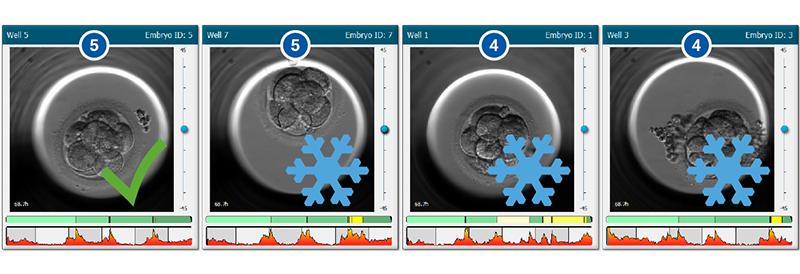 With the introduction of time-lapse technology, the field of assisted reproduction takes a leap forward. Time-lapse monitoring systems present a significant step in improving IVF treatment on all levels. Time-lapse technology introduces new opportunities in the clinic for improved workflow, quality control and communication between embryologists, clinicians and patients.
With the introduction of time-lapse technology, the field of assisted reproduction takes a leap forward. Time-lapse monitoring systems present a significant step in improving IVF treatment on all levels. Time-lapse technology introduces new opportunities in the clinic for improved workflow, quality control and communication between embryologists, clinicians and patients.
But most importantly, time-lapse has developed into a powerful and well-proven method for ensuring undisturbed culture of embryos, while providing invaluable detailed insight into embryo development. With this, time-lapse allows more informed decisions in embryo selection compared to conventional microscopy. In this blog post, I will discuss how a decision support tool can help you enhance your embryo selection from the information obtained with time-lapse imaging.
Supporting IVF decisions
With KIDScore decision support tool, Vitrolife takes embryo selection a step further. KIDScore for day 3 transfers is an exclusive feature of the EmbryoScope time-lapse system and is based on analysis of the world’s largest database of Known Implantation Data (KID).
The decision support tool provides a morphokinetic grade based on actual implantation outcome derived from a multi-center analysis, supporting embryo evaluation on day 3. The high quality bright field images allow you to see detailed embryo features and to use your own knowledge and experience to make the final embryo selection.
Based on actual day 3 transfer outcome
KIDScore decision support tool is based on knowledge about embryos with known clinical outcome. At Vitrolife, we refer to this knowledge as KID (Known Implantation Data). The current database containing this knowledge holds comprehensive information about embryo development profiles from over 30.000 embryos with known implantation outcome.
Embryologists and IVF clinics around the world have contributed to the database since 2009 and analysis has revealed that there are clear morphokinetic features of human embryos, which correlate with a low implantation potential. When based on these universal features, decision support tools rely on a robust data set and can be applied by a wide range of clinics.
A safe decision support tool using avoidance criteria rather than selection criteria
 Thanks to the contribution of IVF clinics worldwide, Vitrolife’s large database makes it possible to distinguish broad statistical patterns that are generally applicable. Starting from 17,500 KID embryos, a subset of 3,300 KID embryos was used to create a basic kinetic model, KIDScore, for day 3 embryo transfers. The embryos used for this analysis were all transferred on day 3, and therefore include embryos which may not have reached blastocyst if cultured to day 5.
Thanks to the contribution of IVF clinics worldwide, Vitrolife’s large database makes it possible to distinguish broad statistical patterns that are generally applicable. Starting from 17,500 KID embryos, a subset of 3,300 KID embryos was used to create a basic kinetic model, KIDScore, for day 3 embryo transfers. The embryos used for this analysis were all transferred on day 3, and therefore include embryos which may not have reached blastocyst if cultured to day 5.
It is designed as an avoidance model, meaning that embryos ranked low by the model have a statistically low chance of implanting. This allows IVF professionals to avoid transferring embryos with a low chance of becoming a baby. In comparison, embryos ranked high by the model have a statistically higher chance of implanting.
Universal to all clinics and can be used immediately without building data
KIDScore D3 decision support tool is designed using few variables which are quick and easy to annotate consistently and objectively: PN assessment, PN fading, time (t) to 2,3,4,5 and 8 cells. KIDScore then provides a morphokinetic score from 1-5 to your annotated embryos. The score from 1-5 is a relative measure of the implantation potential of the embryo. The difference in implantation potential between the scores has a high discrimination range; for example a score of 5 has 7 times the implantation potential as a score 1 and more than twice the implantation potential of a score 3.

All clinics, regardless of clinical practice, can start enjoying benefits of time-lapse for embryo evaluation immediately using KIDScore. IVF clinics do not need to collect their own data before applying the decision support tool to the cohort of embryos. In this way, the use of the KIDScore D3 decision support tool allows IVF clinics to use time-lapse information to improve embryo evaluation without existing data.
As KIDScore is based entirely on morphokinetics and statistical chance, morphology should be added after ranking. Although a computer can rank embryos by morphokinetic values, embryos with the same or similar score may have other morphological features which are best assessed by an experienced embryologist. The excellent bright-field image quality of embryos in the EmbryoViewer software allows embryologists to use all of the information possible to make the best decision.
Tried, tested and trusted
Vitrolife has been dedicated to IVF research since 1994 and our time-lapse systems are developed by the pioneers in clinical time-lapse for IVF. Our products are developed based on customer input and have documented success in human clinical use. More than 300 000 patients worldwide have been treated with our time-lapse systems. Amongst other products, this has allowed the development of a decision support tool like KIDScore - a safe, robust and easy to use model that provides the immediate benefit of using time-lapse for embryo evaluation.
Learn more about KIDScore decision support tool and what our KIDScore users say on our website.
Topics: Time-lapse
Written by Dr. Markus Montag
Markus is a well-known researcher in the field of IVF, where one of his specialities is time-lapse. He has more than 20 years’ experience as Lab Director. Markus spends his time working as a consultant for IVF centres around the world and also for Vitrolife.